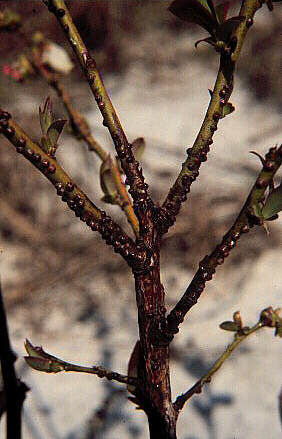Terrapin Scale in Blueberries
go.ncsu.edu/readext?251467
en Español / em Português
El inglés es el idioma de control de esta página. En la medida en que haya algún conflicto entre la traducción al inglés y la traducción, el inglés prevalece.
Al hacer clic en el enlace de traducción se activa un servicio de traducción gratuito para convertir la página al español. Al igual que con cualquier traducción por Internet, la conversión no es sensible al contexto y puede que no traduzca el texto en su significado original. NC State Extension no garantiza la exactitud del texto traducido. Por favor, tenga en cuenta que algunas aplicaciones y/o servicios pueden no funcionar como se espera cuando se traducen.
Português
Inglês é o idioma de controle desta página. Na medida que haja algum conflito entre o texto original em Inglês e a tradução, o Inglês prevalece.
Ao clicar no link de tradução, um serviço gratuito de tradução será ativado para converter a página para o Português. Como em qualquer tradução pela internet, a conversão não é sensivel ao contexto e pode não ocorrer a tradução para o significado orginal. O serviço de Extensão da Carolina do Norte (NC State Extension) não garante a exatidão do texto traduzido. Por favor, observe que algumas funções ou serviços podem não funcionar como esperado após a tradução.
English
English is the controlling language of this page. To the extent there is any conflict between the English text and the translation, English controls.
Clicking on the translation link activates a free translation service to convert the page to Spanish. As with any Internet translation, the conversion is not context-sensitive and may not translate the text to its original meaning. NC State Extension does not guarantee the accuracy of the translated text. Please note that some applications and/or services may not function as expected when translated.
Collapse ▲The terrapin scale, Mesolecanium nigrofasciatum (Pergande), is an occasional pest of tree fruits and shrubs throughout much of the southern and eastern United States. Like other scale insects, this species remains immobile (sessile) throughout most of its life cycle and secretes a rigid, hemispherical covering over its body. This protective cover(called a derm) is brown or reddish-brown and distinctively marked with radiating black bands resembling the shell of a turtle. The derm increases in size as the insect grows, eventually reaching a diameter of 3 to 4 mm (about 1/8 inch).

Blueberry stem infested with terrapin scale (Mesolecanium nigrofasciatum) during early spring (before crawler emergence). Photo: John Meyer.
Biology
There is only one generation of the terrapin scale per year. Mated females overwinter on host plant stems (usually from the previous season’s growth), and bear live young over a period of 4 to 6 weeks in early summer. The young scale insects, known as crawlers, migrate to the leaves where they settle along the mid-rib and veins (usually on the underside) and begin to secrete a derm. Development continues on the leaves for six to eight weeks. In late summer, females migrate back to the stems and undergo a period of rapid growth and sexual development. Males remain on the leaves until they become sexually mature; then they migrate to the stems, mate with the females, and die within a few days. Females continue to feed and develop on the stems until forced into dormancy by cold weather.
Significance and damage
Since scale insects feed by removing sap from a plant, they can reduce vigor, decrease yield, and even shorten the lifespan of infested bushes. Heavy infestations also produce large quantities of honeydew. This sugary waste product often coats the foliage, fostering growth of a sooty mold that blocks light and reduces the plant’s photosynthetic efficiency.
Management
Biological control
Numerous parasites and predators have been reported attacking the terrapin scale (Williams and Kosztarab 1972). The most abundant parasites are tiny chalcid wasps in the genera Aphycus and Coccophagus that attack female scales following the stemward migration. A ladybeetle, Hyperaspis binotata, is the most common predator. In some cases, these natural enemies exert significant restraint on the growth of scale populations, but hyperparasites are also abundant and the level of control tends to be variable from year to year.
Cultural and chemical control
Terrapin scale populations can be detected at any time during the year, but they are most conspicuous in late summer when sooty mold coats the foliage or in autumn after the leaves have fallen. Young scale can also be found earlier in the summer by examining the undersides of leaves.
It is nearly impossible to control the terrapin scale with insecticide treatments applied during the growing season because the scale covering is impervious to most materials. The best results are obtained when applications are timed to coincide with the active period of the crawlers or when dormant oil sprays are applied before bud break in the spring. Careful pruning can also help control light or scattered infestations of scale insects. See the North Carolina Agricultural Chemicals Manual for specific management information.
References and more information
Hamon, A. B., and M. L. Williams. 1984. The soft scale insects of Florida (Homoptera: Coccoidea: Coccidae). pp. 63-65. In: Arthropods of Florida. Vol. 11. Florida Dept. Agr. and Consumer Serv.
Simanton, F. L. 1916. The terrapin scale: an important insect enemy of peach orchards. USDA Bull. 351. 96 pp.
Williams, M. L., and M. Kosztarab. 1972. Morphology and systematics of the Coccidae of Virginia with notes on their biology (Homoptera: Coccidae). Va. Polytech. Inst. and State Univ. Res. Div. Bull. 74: 84-90.


